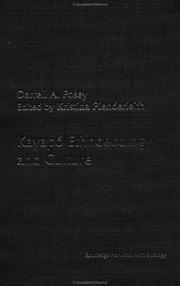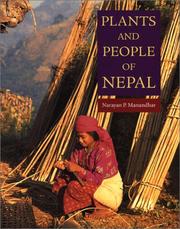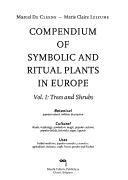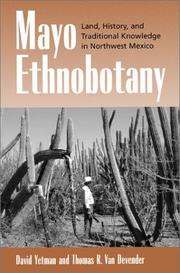| Listing 1 - 7 of 7 |
Sort by
|

ISBN: 0820323497 Year: 2002 Publisher: Athens (Ga) : University of Georgia press,
Abstract | Keywords | Export | Availability | Bookmark
 Loading...
Loading...Choose an application
- Reference Manager
- EndNote
- RefWorks (Direct export to RefWorks)
Biodiversity conservation --- Biodiversity --- Ethnobiology --- Multiculturalism
Book
ISBN: 393162112X Year: 2002 Publisher: Frankfurt am Main
Abstract | Keywords | Export | Availability | Bookmark
 Loading...
Loading...Choose an application
- Reference Manager
- EndNote
- RefWorks (Direct export to RefWorks)
Poaceae --- Gramineae --- edible plants --- ethnobiology --- economic botany --- food plants --- Secale --- Triticum --- Avena --- Oryza --- Zea

ISBN: 1134471424 0415753783 1280098554 0203220196 9780203220191 9780415277914 0415277914 9786610098552 6610098557 9781134471423 9781134471379 1134471378 9781134471416 1134471416 9780415753784 0415277914 9781280098550 Year: 2002 Volume: 6 Publisher: London ; New York : Routledge,
Abstract | Keywords | Export | Availability | Bookmark
 Loading...
Loading...Choose an application
- Reference Manager
- EndNote
- RefWorks (Direct export to RefWorks)
Darrell A Posey died in March 2001 after a long and distinguished career in anthropology and ecology. Kayapó Ethnoecology and Culture presents a selection of his writings that result from 25 years of work with the Kayapó Indians of the Amazon Basin. These writings describe the dispersal of the Kayapó sub-groups and explain how with this diaspora useful biological species and natural resource management strategies also spread. However the Kayapó are threatened with extinction like many of the inhabitants of the Amazon basin. The author is adamant that it is no longer satisfactory for s
Cayapo Indians --- Ethnoecology --- Caiapo Indians --- Ibirayara Indians --- Kaiapó Indians --- Kayapo Indians --- Mẽbêngôkre Indians --- Gê Indians --- Indians of South America --- Indigenous peoples --- Human ecology --- Traditional ecological knowledge --- Ethnobotany. --- Ethnobiology. --- Agriculture. --- Ecology --- Gorotire (Brazil) --- Social life and customs. --- Environmental conditions. --- Aboriginal peoples --- Aborigines --- Adivasis --- Indigenous populations --- Native peoples --- Native races --- Ethnology --- Ethnobotany --- Ethnobiology --- Agriculture --- Social life and customs --- Environmental conditions --- Cayapo Indians - Ethnobotany --- Cayapo Indians - Ethnobiology --- Cayapo Indians - Agriculture --- Indigenous peoples - Ecology - Brazil - Gorotire --- Gorotire (Brazil) - Social life and customs --- Gorotire (Brazil) - Environmental conditions

ISBN: 0881925276 Year: 2002 Publisher: Portland : Timber Press,
Abstract | Keywords | Export | Availability | Bookmark
 Loading...
Loading...Choose an application
- Reference Manager
- EndNote
- RefWorks (Direct export to RefWorks)
RANGING IN elevation from just above sea level to the peak of the world's highest mountain, Nepal embraces a profusion of habitats for plants and people. The author of Plants and People of Nepal, Narayan P. Manandhar, has spent decades in a firsthand study of the ethnobotanical riches of Nepal's flora. He has conducted field research in all 75 districts of Nepal, on foot, in a lifelong effort to identify the plants and record their traditional roles in Nepalese society. The result is this book, his magnum opus, in which he describes the uses of an astonishing 1517 kinds of plants belonging to 858 genera 195 families, equal to perhaps one-fifth of the entire Nepalese flora. Many of the plants have more than one application, and 1002 medicinal plants, 651 food plants, and 696 plants used for a rich variety of other purposes are recorded here. This indigenous wisdom is dying with the older generation, so we are fortunate that Dr. Manandhar has rescued this heritage for his fellow Nepalese and, indeed, all who are concerned about the wealth of knowledge to be obtained from this fascinating country. Nepal's many ethnic groups make their own distinctive uses of the plants. A chapter describes 14 of the most important groups, including details on festivals, marriage customs, burial ceremonies, and other aspects of their cultures. An appendix organizes the plants by usage and serves as a practical cross-reference to the core of the book, the alphabetically arranged compilation. The author has provided an index to the more than 6800 vernacular plant names as well as a bibliography, glossary, and index of scientific names. More than 830 drawings and 48 color photographs by the author illustrate the text.
ETH Ethnobotany & Economic botany --- East Africa --- Nepal --- botanical drawings --- ethnobotany --- Ethnobotany --- Indigenous peoples --- Ethnobiology --- Plants --- Human-plant relationships --- Ethnobotany. --- Plants, Useful. --- Ethnobotanique --- Plantes utiles --- Plantes sauvages --- Plantes médicinales --- Népal.

ISBN: 9077135049 Year: 2002 Publisher: Ghent Man&Culture
Abstract | Keywords | Export | Availability | Bookmark
 Loading...
Loading...Choose an application
- Reference Manager
- EndNote
- RefWorks (Direct export to RefWorks)
Ethnobotany. --- plantlore --- magic plants --- symbolism --- Ethnobotany --- Medicinal plants --- Plants --- Flora --- Plant kingdom --- Plantae --- Vascular plants --- Vegetable kingdom --- Vegetation --- Wildlife --- Organisms --- Botany --- Drug plants --- Plants, Useful --- Botanical drug industry --- Botany, Medical --- Materia medica, Vegetable --- Psychotropic plants --- Indigenous peoples --- Ethnobiology --- Human-plant relationships --- Religious aspects --- Folklore --- Pharmacognosy --- Esoteric sciences --- Flore. Botanic determination guides --- Folklore. --- Plants, Medicinal. --- Religion and Medicine. --- Religious aspects.

ISBN: 1282356348 0520926358 9786612356346 1597347396 9780520926356 0585466122 9780585466125 9781597347396 9780520227217 0520227212 6612356340 0520227212 9781282356344 Year: 2002 Publisher: Berkeley : University of California Press,
Abstract | Keywords | Export | Availability | Bookmark
 Loading...
Loading...Choose an application
- Reference Manager
- EndNote
- RefWorks (Direct export to RefWorks)
The Mayos, an indigenous people of northwestern Mexico, live in small towns spread over southern Sonora and northern Sinaloa, lands of remarkable biological diversity. Traditional Mayo knowledge is quickly being lost as this culture becomes absorbed into modern Mexico. Moreover, as big agriculture spreads into the region, the natural biodiversity of these lands is also rapidly disappearing. This engaging and accessible ethnobotany, based on hundreds of interviews with the Mayos and illustrated with the authors' strikingly beautiful photographs, helps preserve our knowledge of both an indigenous culture and an endangered environment. This book contains a comprehensive description of northwest Mexico's tropical deciduous forests and thornscrub on the traditional Mayo lands reaching from the Sea of Cortés to the foothills of the Sierra Madre. The first half of the book is a highly readable account of the climate, geology, and vegetation of the region. The authors also provide a valuable history of the people, their language, culture, festival traditions, and plant use. The second half of the book is an annotated list of plants presenting the authors' detailed findings on plant use in Mayo culture.
Ethnobotany --- Mayo Indians --- Indigenous peoples --- Ethnobiology --- Plants --- Human-plant relationships --- Yolem'me Indians --- Yoreme Indians --- Cahita Indians --- Indians of Mexico --- Ethnobotany. --- Ethnology. Cultural anthropology --- Phytogeography --- Sinaloa --- Sonora --- agiabampo. --- agriculture. --- anthropology. --- arroyo. --- biodiversity. --- botany. --- climate. --- conservation. --- deciduous forest. --- environment. --- environmentalism. --- ethnobotany. --- festivals. --- folklore. --- geology. --- herbal medicine. --- indigenous culture. --- indigenous peoples. --- mayos. --- mexico. --- nonfiction. --- northwestern mexico. --- plant use. --- rite. --- ritual. --- science. --- sea of cortes. --- sierra madre. --- sinaloa. --- sonora. --- thorn scrub. --- tradition. --- tropical forest. --- vegetation.

ISBN: 9780444508522 044450852X 9780080531250 0080531253 9786611054939 1281054933 Year: 2002 Volume: 1 Publisher: Amsterdam ; New York : Elsevier,
Abstract | Keywords | Export | Availability | Bookmark
 Loading...
Loading...Choose an application
- Reference Manager
- EndNote
- RefWorks (Direct export to RefWorks)
The emergence of new infectious, chronic and drug resistant diseases have prompted scientists to look towards medicinal plants as agents for treatment and prevention. This book provides an interphase between ethnomedical and ethnobotanical approaches to new drug discovery and advances in biotechnology and molecular science that has made it increasingly feasible to transform traditional medicines into modern drugs. These novel approaches also raise new issues and the volume explores economic, ethical and policy considerations of drug development based on indigenous knowledge or traditional me
Botany --- Pharmacognosy --- Human medicine --- Pharmacognosy. --- Ethnobotany. --- Medicinal plants. --- Materia medica, Vegetable. --- Botanical drugs --- Drugs from plants --- Medicinal plants --- Phytotherapy --- Plant drugs --- Vegetable drugs --- Materia medica --- Botanical drug industry --- Botany, Medical --- Drug plants --- Plants, Useful --- Materia medica, Vegetable --- Psychotropic plants --- Indigenous peoples --- Ethnobiology --- Plants --- Human-plant relationships --- Pharmacognostics --- Drugs --- Pharmacy --- Therapeutic use --- Ethnobotany --- Medicine, Traditional. --- Herbal Medicine. --- Plants, Medicinal. --- Pharmacognosie --- Ethnobotanique --- Plantes médicinales --- Phytothérapie
| Listing 1 - 7 of 7 |
Sort by
|

 Search
Search Feedback
Feedback About
About Help
Help News
News